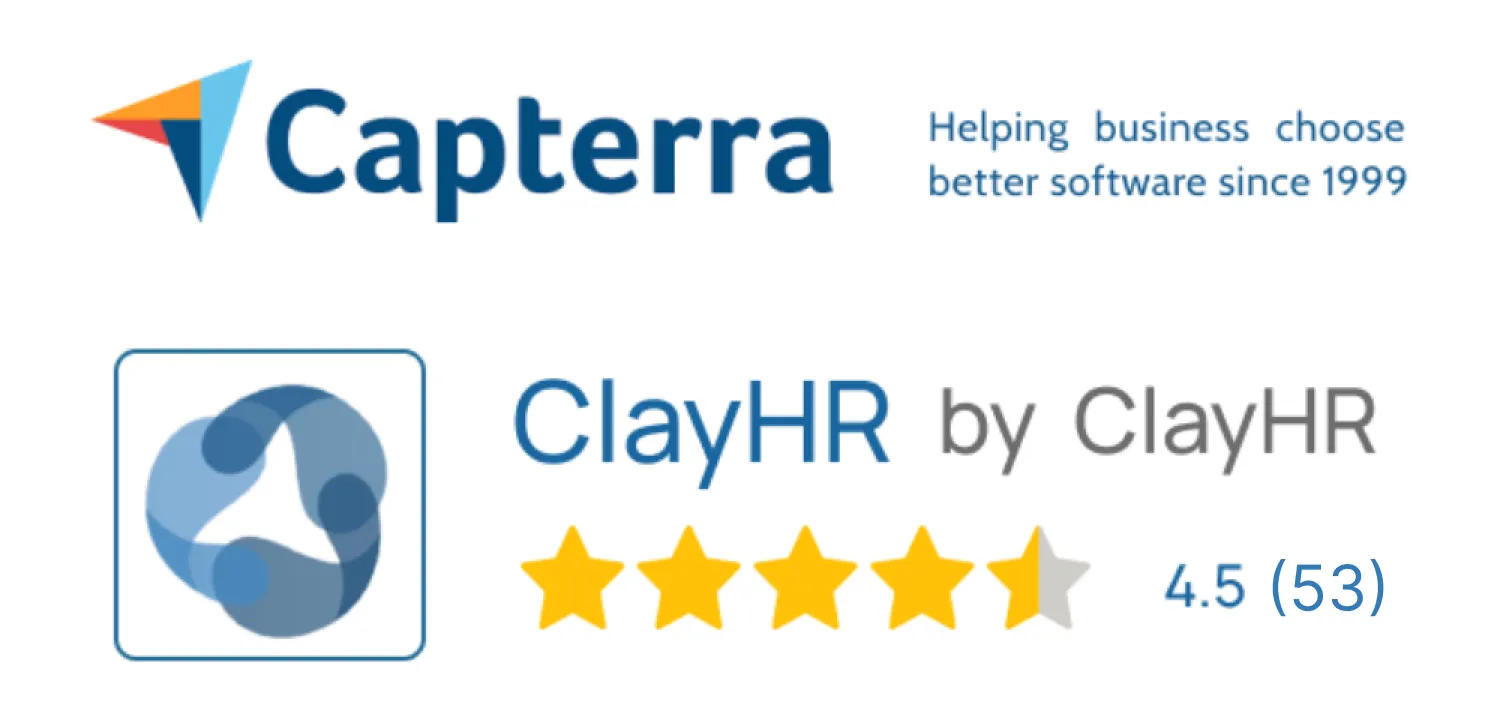ClayHR - Oracle EBS Integration
To integrate ClayHR with Oracle EBS, you can utilize the web service capabilities of both systems. The ClayHR exposes web services that allow Oracle EBS to retrieve or update data in the ClayHR system. Similarly, depending on your setup, Oracle EBS can expose web services that enable ClayHR to access relevant data or perform certain operations in the Oracle EBS system.
Case 1: Push HR Data from ClayHR to Oracle EBS
When developing a web service in the Oracle EBS and ClayHR consumes it to push HR data to Oracle EBS, we can follow these general steps:
- Define the Web Service: Determine the specific HR data that needs to be pushed from ClayHR to Oracle EBS. Define the structure and functionality of the web service, including the input parameters and expected data format.
- Create the Web Service in Oracle Database: Use Oracle Integrated SOA Suite or other tools available in your EBS version to develop the web service. Specify the service interface, implement the necessary logic, and define any required transformations or validations.
- Expose the Web Service Endpoint: Once the web service is Developed, expose its endpoint URL, which ClayHR will use to send data to the Oracle EBS system. Configure the necessary security measures, such as authentication and authorization, to ensure secure communication.
- Implement Data Transformation (if needed): If the data format sent by ClayHR differs from the expected format in Oracle EBS, you may need to implement data transformations or mappings to ensure compatibility between the systems.
- Implement Error Handling: Define appropriate error handling mechanisms within the web service to handle any potential errors or exceptions that may occur during data transmission. Consider implementing retries, logging, and appropriate error messages to facilitate troubleshooting and resolution.
- Integrate ClayHR with the Web Service: In the ClayHR system, implement the necessary logic to consume the web service. This typically involves making HTTP(s) requests to the web service endpoint, passing the HR data in the specified format, and handling the responses or error messages returned by the web service.
- Test and Validate the Integration: Perform thorough testing to verify that ClayHR can successfully push HR data to the Oracle EBS system via the web service. Test different scenarios, including data validation, error handling, and performance testing, to ensure reliable and accurate data transmission.
- Monitor and Maintain the Integration: Once the integration is live, monitor its performance and ensure its ongoing functionality. Regularly review logs, monitor data accuracy, and address any issues or enhancements that arise over time.
Case 2: Pull HR Data from Oracle EBS into ClayHR
Developing a web service in the Oracle EBS and ClayHR consumes it to pull HR data from Oracle EBS, we can follow these general steps:
- Identify the HR Data to Pull: Determine the specific HR data that needs to be retrieved from Oracle EBS. This could include employee information, timesheets, leave records, or any other relevant data.
- Design the Web Service Endpoint: Define the structure and functionality of the web service endpoint that will expose the HR data from Oracle EBS. Determine the appropriate parameters and data format (XML or JSON) for the request and response.
- Implement the Web Service Endpoint: Develop the web service endpoint within Oracle EBS using the chosen mechanism, such as Integrated SOA, PL/SQL with UTL_HTTP, or APEX with ORDS. Write the necessary code or configuration to fetch the HR data from the EBS database and expose it as a web service.
- Secure the Web Service Endpoint: Configure appropriate security measures for the web service endpoint to ensure authorized access. Implement authentication and authorization mechanisms to control who can pull the HR data.
- Integrate ClayHR with the Web Service: In the ClayHR system, implement the logic to consume the web service and retrieve the HR data. This typically involves making HTTP(s) requests to the web service endpoint, passing any required parameters, and processing the received response to extract the necessary HR data.
- Handle Data Transformation (if needed): If the format of the HR data received from Oracle EBS differs from the expected format in ClayHR, you may need to implement data transformations or mappings to ensure compatibility between the systems.
- Implement Error Handling: Define error handling mechanisms within the integration to handle potential errors or exceptions that may occur during data retrieval. Consider implementing proper error messages, logging, and retry mechanisms to ensure data integrity and troubleshooting capabilities.
- Test and Validate the Integration: Perform thorough testing to verify that ClayHR can successfully retrieve HR data from Oracle EBS using the web service integration. Test different scenarios, handle errors, and validate the accuracy of the data retrieved.
- Monitor and Maintain the Integration: Once the integration is live, monitor its performance and ensure its ongoing functionality. Regularly review logs, monitor data accuracy, and address any issues or enhancements that arise over time.
Case 3: Push HR Data from Oracle EBS to ClayHR
When developing a web service in the ClayHR and Oracle EBS consumes it to push HR data to ClayHR, we can follow these general steps:
- Identify the HR Data to Push: Determine the specific HR data that needs to be pushed from Oracle EBS to ClayHR. This could include employee information, timesheets, leave records, or any other relevant data.
- Design the Web Service Endpoint in ClayHR: Define the structure and functionality of the web service endpoint in ClayHR that will receive the HR data from Oracle EBS. Determine the appropriate parameters and data format (XML or JSON) for the request.
- Implement the Web Service Endpoint in ClayHR: Develop the web service endpoint within ClayHR to receive the HR data. Write the necessary code or configuration to accept incoming requests and process the received data.
- Secure the Web Service Endpoint: Configure appropriate security measures for the web service endpoint in ClayHR to ensure authorized access. Implement authentication and authorization mechanisms to control who can push the HR data.
- Extract HR Data from Oracle EBS: Determine the method to extract the HR data from Oracle EBS. This can be achieved using various techniques such as SQL queries, PL/SQL procedures, or utilizing Oracle EBS APIs, depending on the specific data requirements.
- Transform HR Data (if needed): If the format of the HR data extracted from Oracle EBS differs from the expected format in ClayHR, you may need to implement data transformations or mappings to ensure compatibility.
- Implement the Integration Logic: Develop the logic within Oracle EBS to invoke the web service endpoint in ClayHR. This can be achieved using mechanisms such as PL/SQL with UTL_HTTP, or APEX with ORDS. Write the necessary code or configuration to make HTTP(s) requests to the ClayHR web service endpoint and pass the HR data.
- Handle Error Handling and Logging: Implement error handling mechanisms within the integration logic to handle potential errors or exceptions that may occur during data transmission. Consider logging the integration activities for troubleshooting and monitoring purposes.
- Test and Validate the Integration: Perform thorough testing to verify that the HR data from Oracle EBS is successfully pushed to ClayHR using the web service integration. Test different scenarios, handle errors, and validate the accuracy of the data pushed.
- Monitor and Maintain the Integration: Once the integration is live, monitor its performance and ensure its ongoing functionality. Regularly review logs, monitor data accuracy, and address any issues or enhancements that arise over time.
Case 4: Pull HR Data from ClayHR to Oracle EBS
When developing a web service in the ClayHR and Oracle EBS consumes it to pull HR data from ClayHR, we can follow these general steps:
- Identify the HR Data to Pull: Determine the specific HR data that needs to be retrieved from ClayHR. This could include employee information, timesheets, leave records, or any other relevant data.
- Design the Web Service Endpoint in ClayHR: Define the structure and functionality of the web service endpoint in ClayHR that will expose the HR data. Determine the appropriate parameters and data format (XML or JSON) for the request and response.
- Implement the Web Service Endpoint in ClayHR: Develop the web service endpoint within ClayHR using the chosen mechanism. Write the necessary code or configuration to fetch the HR data from ClayHR and expose it as a web service.
- Secure the Web Service Endpoint: Configure appropriate security measures for the web service endpoint in ClayHR to ensure authorized access. Implement authentication and authorization mechanisms to control who can access the HR data.
- Integrate Oracle EBS with the Web Service: In Oracle EBS, implement the logic to consume the web service and retrieve the HR data from ClayHR. This typically involves making HTTP(s) requests to the web service endpoint, passing any required parameters, and processing the received response to extract the necessary HR data.
- Handle Data Transformation (if needed): If the format of the HR data received from ClayHR differs from the expected format in Oracle EBS, you may need to implement data transformations or mappings to ensure compatibility between the systems.
- Implement Error Handling: Define error handling mechanisms within the integration to handle potential errors or exceptions that may occur during data retrieval. Consider implementing proper error messages, logging, and retry mechanisms to ensure data integrity and troubleshooting capabilities.
- Test and Validate the Integration: Perform thorough testing to verify that Oracle EBS can successfully retrieve HR data from ClayHR using the web service integration. Test different scenarios, handle errors, and validate the accuracy of the data retrieved.
- Monitor and Maintain the Integration: Once the integration is live, monitor its performance and ensure its ongoing functionality. Regularly review logs, monitor data accuracy, and address any issues or enhancements that arise over time.










